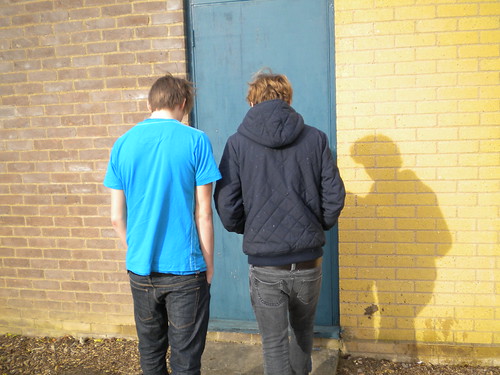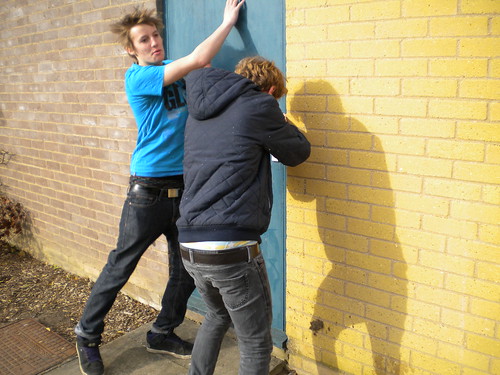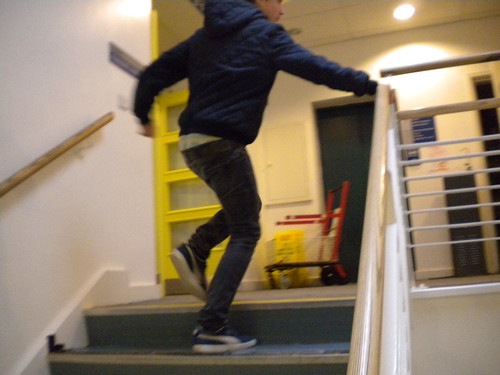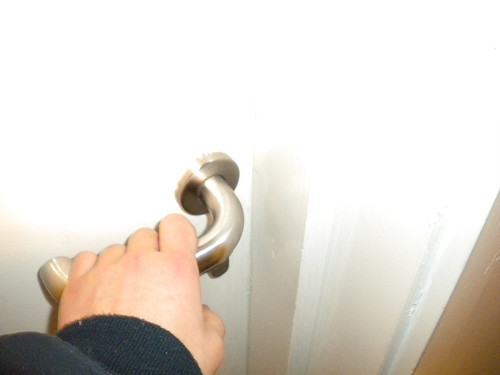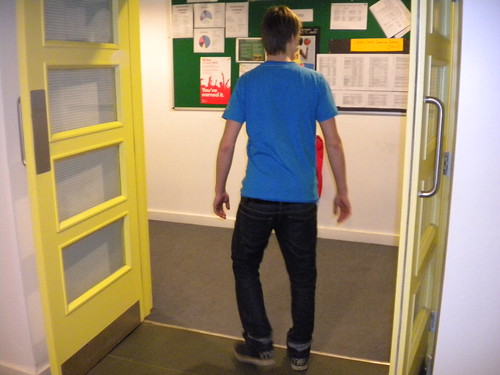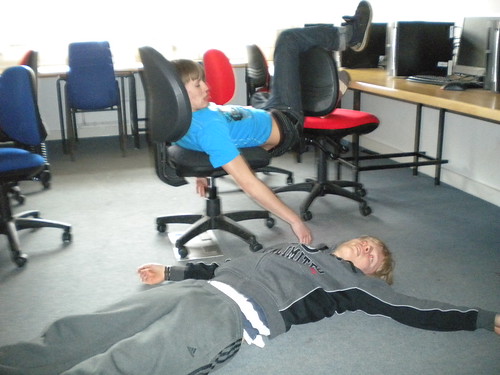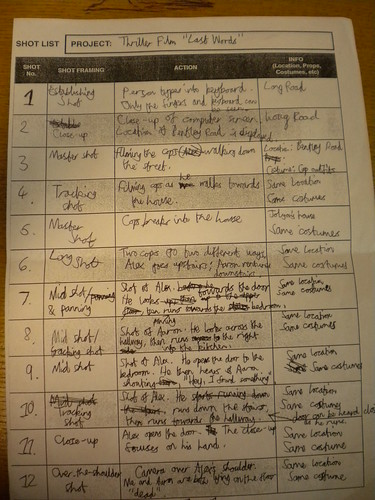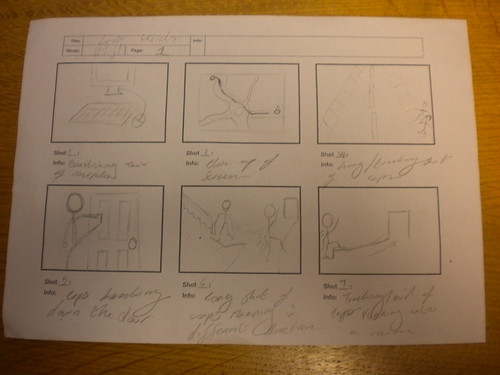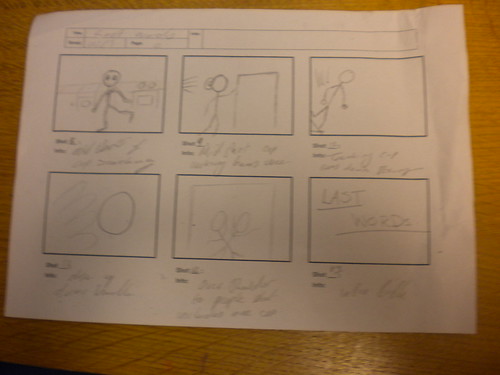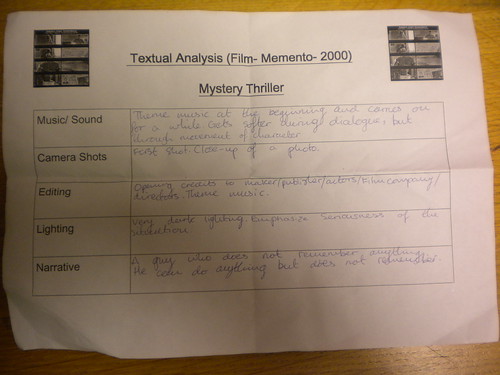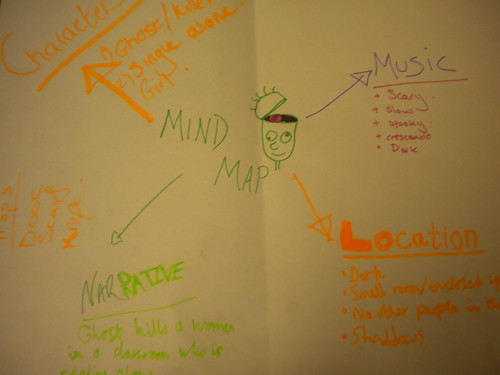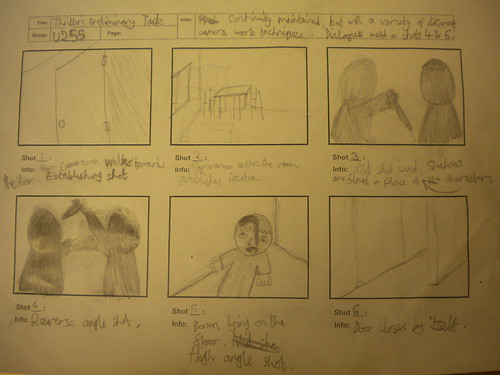We recieved feedback from our peers. it was fun. we had fun. i like fun. its fun
overall we recived good feedback for our camerawork. they said we have used a wide variety of shots including split screen
Friday, 18 March 2011
Thursday, 17 March 2011
P1-02 "Negative" thriller analysis
From having analysed this groups thriller, I noticed that the group used a soundtrack that was quite slow and creates a melancholy sort of mood for the whole thriller. This helped us learn something about the pace of thrillers and what sort of music should be used.
For example, our thriller is a crime thriller, and a lot of short shots are used and the character's movements are quite fast when they are running through the house so it's important that we don't make our soundtrack too slowly paced because this won't match up well to the conventions of our sub-genre and therefore the film won't look quite as good a standard as we would like it to be.
For example, our thriller is a crime thriller, and a lot of short shots are used and the character's movements are quite fast when they are running through the house so it's important that we don't make our soundtrack too slowly paced because this won't match up well to the conventions of our sub-genre and therefore the film won't look quite as good a standard as we would like it to be.
P2-35 thriller rough cut analysis
From having analysed this groups rough cut we have learned about something we could use to our advantage in our thriller. Basically, it would work well if we made some of our shots a bit shorter and cut out anything that isn't necessarily important to have in our film so that a fast pace is created in our thriller. Since our thriller is a crime thriller, it makes sense for it to have a fast pace just like the rough cut produced by this group so that it matches with the sort of pace that would be expected from a typical thriller film.
T2-49 thriller rough cut analysis
From having watched a rough cut of a thriller produced by another group (T2-49) we learned about what sort of instruments/effects we could use in our soundtrack. For example, the drumbeat that was used in their rough cut fitted together nicely with the piano music to create a dark and suspenseful mood for their thriller, and therefore it makes sense to us that we should try something similar for our soundtrack.
A similar drumbeat and another tune that is low in pitch when put together in our soundtrack could create the dark and suspenseful mood that we want to portray in our thriller film.
A similar drumbeat and another tune that is low in pitch when put together in our soundtrack could create the dark and suspenseful mood that we want to portray in our thriller film.
P1-01 Dead Runner thriller analysis
In preparation for our final bits of editing for our film we decided to look at some other thrillers done by groups who were past students at long road.
Therefore, we chose to analyse a thriller done by group P1-01 called "Dead Runner", and from having watched it all the way through we learned from it and came up with a few ideas. For example, we thought it would be good to make some of our shots darker by using a colour changer on Final Cut Express and we hope to use this to darken the first few shots in our thriller. The reason for this is that it makes some of our shots look more eerie/creepy and therefore this fits with the typical conventions of a thriller.
Therefore, we chose to analyse a thriller done by group P1-01 called "Dead Runner", and from having watched it all the way through we learned from it and came up with a few ideas. For example, we thought it would be good to make some of our shots darker by using a colour changer on Final Cut Express and we hope to use this to darken the first few shots in our thriller. The reason for this is that it makes some of our shots look more eerie/creepy and therefore this fits with the typical conventions of a thriller.
Wednesday, 16 March 2011
11th February media lesson - what we learned
During this lesson we tried to work with the footage we took from the day before and try to do some editing. This certainly wasn't an issue considering we'd already taken so much footage the previous day,
however it would've helped if we had thought about how effectively the shots would flow from one to the other to maintain continuity, because since we had a few shots missing this made it difficult to get a basic rough cut that was up to 2 minutes long.
From this we learned that it is important to make sure that your actors are concentrating very hard when you are out filming so that you don't have to take a ridiculous number of shots of the same action where your actors are laughing/smirking/etc and waste time that could've been better used taking other shots.
however it would've helped if we had thought about how effectively the shots would flow from one to the other to maintain continuity, because since we had a few shots missing this made it difficult to get a basic rough cut that was up to 2 minutes long.
From this we learned that it is important to make sure that your actors are concentrating very hard when you are out filming so that you don't have to take a ridiculous number of shots of the same action where your actors are laughing/smirking/etc and waste time that could've been better used taking other shots.
15th February media lesson - what we learned
During this session was our second day of filming at Bentley Road. On this day we made sure we were extra careful when it came to what time we had to be back at college and we re-took several shots on this day to make sure that we had most of the shots we needed to maintain continuity effectively throughout the thriller. There was one particular scene in our thriller where, if the ketchup wasn't already there, we would've struggled to take shots for it and that was the scene where Alex and Jolyon are on the floor dead and this shot wouldn't have worked without the ketchup because it wouldn't have looked shocking enough to be in our thriller. Basically if there was no ketchup in the fridge on that day it would've made us unable to film these shots, so what we learned from this is that it is important to make sure that you have all the things you need when you are trying to film a particular scene in a film because your film may not relate to its genre quite so well if you don't use them.
8th February media lesson - what we learned
During this lesson, there were two things we had to finish in preparation for our filming session the following week which were the mind map and the shooting schedule. Although a shooting schedule had already been done we still needed to improve it and create a mind map showing all the conventions of typical thrillers, the sort of soundtrack we wanted to use and the location itself as well as other factors that would contribute to our film planning which are all mentioned on our mind map post.
From this lesson, we learned that it helps to finish your planning stages for your project as soon as possible so that you can do other posts that could get you extra marks for your thriller planning; otherwise you can end up losing time that you could've had to do these. That said however, we did manage to put up a post mentioning what we learned from Amar's presentation, which is mentioned on another post titled "What We Learned From Amar", so we actually did manage to get an extra post on the blogger, but even then we could've finished our planning stages sooner so we could've done more of these.
From this lesson, we learned that it helps to finish your planning stages for your project as soon as possible so that you can do other posts that could get you extra marks for your thriller planning; otherwise you can end up losing time that you could've had to do these. That said however, we did manage to put up a post mentioning what we learned from Amar's presentation, which is mentioned on another post titled "What We Learned From Amar", so we actually did manage to get an extra post on the blogger, but even then we could've finished our planning stages sooner so we could've done more of these.
10th February media lesson - what we learned
During this lesson we went over to Bentley Road to start filming for our thriller project, and we took a lot of footage on this particular day so that we would have a lot of different shots to use in our thriller.
However, when you are doing a lot of filming in one day it is easy to get too ambitious and try to finish every shot right up to the end of the thriller for the sake of getting as much as you can get finished, so it is very important to make sure that when you actually do your filming for that day that you've actually saved enough time for you and your group to get back to college in time and carefully consider what shots you might need to take during your next filming session if there are any that you've missed.
All in all, from this filming session we learned that it is important not to go overboard trying to film a ridiculously large amount of footage if the group puts itself at risk of getting back to college to upload the footage, as this can make the whole group suffer as a result.
However, when you are doing a lot of filming in one day it is easy to get too ambitious and try to finish every shot right up to the end of the thriller for the sake of getting as much as you can get finished, so it is very important to make sure that when you actually do your filming for that day that you've actually saved enough time for you and your group to get back to college in time and carefully consider what shots you might need to take during your next filming session if there are any that you've missed.
All in all, from this filming session we learned that it is important not to go overboard trying to film a ridiculously large amount of footage if the group puts itself at risk of getting back to college to upload the footage, as this can make the whole group suffer as a result.
17th February media lesson - what we learned
Since we took lots of footage for our thriller two days before this date we thought it would be a good idea to start uploading our footage and editing it. From doing this, we noticed that some of our shots weren't as good as we would've liked or didn't flow very well, so we thought it would be best to work with the footage we'd already taken and take some more footage the next day at Bentley Road to ensure that our film maintained continuity with each shot. From this lesson, we learned that when we are editing our footage it is important to remember to check for any extra shots you could add or change to improve the thriller in certain aspects so that it actually fits with the codes and conventions of typical thriller films.
Friday, 11 March 2011
18th February media lesson - what we learned
During this lesson, we went over for one last trip to Bentley Road for our final day of filming in that location.
Although we already had most of our footage, we felt that it would be good to retake some of the shots and add a few extra ones to make sure that we had all the shots we needed to maintain continuity in our film and that the shots we took of the characters' actions were actually good enough to be used in our film.
Once again, we saved ourself a 30 minute time slot so that we could finish all the shots ahead of time and get back to college in time to upload our footage. This plan worked to an extent because our group actually managed to get back to the media classroom in time. However, there wasn't really enough time to upload the footage, but since we made it back in time anyway, we agreed to do this next lesson. From this filming session we learned the importance of making sure that we have all the shots we need to maintain continuity in our film and that there is no extra background noise when we are filming, as this can obviously confuse the viewing audience and make them wonder where the sound actually came from. There was no actual background noise interfering with our filming to begin with, but obviously if there was something like a fire engine/police car noise, etc and as we were filming and acting, this would clearly mess up our shots for the thriller and this was something we had realised from our filming session.
Although we already had most of our footage, we felt that it would be good to retake some of the shots and add a few extra ones to make sure that we had all the shots we needed to maintain continuity in our film and that the shots we took of the characters' actions were actually good enough to be used in our film.
Once again, we saved ourself a 30 minute time slot so that we could finish all the shots ahead of time and get back to college in time to upload our footage. This plan worked to an extent because our group actually managed to get back to the media classroom in time. However, there wasn't really enough time to upload the footage, but since we made it back in time anyway, we agreed to do this next lesson. From this filming session we learned the importance of making sure that we have all the shots we need to maintain continuity in our film and that there is no extra background noise when we are filming, as this can obviously confuse the viewing audience and make them wonder where the sound actually came from. There was no actual background noise interfering with our filming to begin with, but obviously if there was something like a fire engine/police car noise, etc and as we were filming and acting, this would clearly mess up our shots for the thriller and this was something we had realised from our filming session.
1st March media lesson - what we learned
Since all of our filming at Bentley Road was finished, we figured that this lesson would be a good time to start uploading our footage and editing it. While doing this, we noticed there were a lot of retakes of some of the shots we did, so we needed to pick the best shots out of the ones we had and put them together in the film so that there was good continuity. This was also a lesson where the soundtrack had to be worked on, so we divided the responsibilities between us, with Aaron and Alex working on the soundtrack and Jolyon and Hope working on the actual editing. This worked well because we all took to our responsibilities and made sure we did the work we were supposed to do. However, when we were putting the shots together we realised that because we were workig with shots that had been taken on different days, we had to make sure there was nothing in any of the shots that would mess up the continuity of the film eg costume changes, changes in actors' appearances, objects, etc. Because of this, it became clear to us that what we learned from this lesson is that it's important to make sure that you try to keep your location as similar as possible to how it was the last time you filmed there, because if you don't this can make some of your shots useless. Thankfully we were able to maintain continuity with most of our shots anyway, but from the work we did, this is what we realised.
3rd March media lesson - what we learned
During this lesson we continued with our editing and got to the point where our film had very good continuity and the shots fitted together effectively. We also had Amar look at our film and give us some feedback. We managed to take down some useful notes from what he said and uploaded them onto the blogger. This was the feedback for rough cut 1, and everything that we learned from this lesson is mentioned in another blog post titled "Rough Cut 1 - Amar's Feedback". All in all, the lesson was very productive and lots of editing was done. However, aside from what we learned from Amar's feedback, we also learned that when we are editing a film, we have to make sure that the responsibilites that come with it, eg: soundtrack, editing, credits etc is all divided evenly between the members of our group, because seeing as we only have two weeks left, it makes sense to organise ourselves in this way so that everything is finished in time and our film has a decent soundtrack as well as the decent continuity it already has.
Thursday, 10 March 2011
4th March Media Lesson - what we learned
On Friday 4th March, we had another media lesson where we had to continue with our editing, and we had already managed to get just over 2 minutes of footage into our thriller. However, when we looked at the feedback we were given from Amar, we thought it would be a good idea to redo the first part of the film. To do this, we went and took an extra shot where a cop and a person at Bentley Road are having a conversation over the phone, but you cannot see either of the characters' faces. This part of the thriller was added to explain the reason why the cops are searching a house at Bentley Road, and from this lesson we learned that if we are taking extra shots in college, it is important to consider your location, because you want to make sure you pick a location that is quiet where you won't be disturbing anyone and where you won't be disturbed yourself, as we found that the location we picked in the college had a lot of people walking past us and therefore this was distracting for our actors. Also, we learned that when we are filming in an open area (outside) we have to make sure that the wind doesn't take all the sound out of the character's voices, otherwise the audience can't hear anything the characters are saying.
Thursday, 3 March 2011
peer feedback on rough cut
The group that commented on our rough cut has informed us that our thriller is difficult to hear, and say that only diegetic sound is used in our production, which is a problem we will fix as soon as we get a soundtrack for our thriller and make sure it doesn't make it harder to hear the characters' dialogue.
It also appears that we had shaky camera work. For some shots we agreed that shaky camera work only added the tension.
The biggest issue was that the group that actually commented on our work didn't really give as enough comments to work from, so we didn't really get as good an idea of what to improve on as we would've liked.
It also appears that we had shaky camera work. For some shots we agreed that shaky camera work only added the tension.
The biggest issue was that the group that actually commented on our work didn't really give as enough comments to work from, so we didn't really get as good an idea of what to improve on as we would've liked.
Rough cut 1 - Amar's feedback
Having finished a rough cut for our thriller production, Amar came to see our film for himself to give us feedback. There were a number of good things in our production and other things we needed to work on which are listed below:
Good points
- pace of editing creates a sense of panic, which is what a viewer would expect from a thriller
- the shots are done very well so that continuity is maintained effectively throughout the film
Things to work on
- we could make it so that shots are flipped to keep a character on one side
- we need to record the sound from the dialogue again so that the audience understands the story better and doesn't get confused
- we need to include an extra shot to give an explanation as to why the cops are exploring a house at Bentley Road
Good points
- pace of editing creates a sense of panic, which is what a viewer would expect from a thriller
- the shots are done very well so that continuity is maintained effectively throughout the film
Things to work on
- we could make it so that shots are flipped to keep a character on one side
- we need to record the sound from the dialogue again so that the audience understands the story better and doesn't get confused
- we need to include an extra shot to give an explanation as to why the cops are exploring a house at Bentley Road
Thursday, 17 February 2011
Thursday, 10 February 2011
Title Sequence Research
Before creating our title sequence we will first need to carry out research into title sequences of the same genre. By doing this we will be able to create a more suitable title sequence.
We looked at two different opening sequences which fit into the thriller genre; Psyco (1960) and Panic Room.
Psyco
The title sequence for the film Psyco is a very simple sequence. This could be because the film was made in 1960's. The background of the title sequence is black, it then fades into the first scene of the film. the duration of the sequence is approximately 50 seconds. The text comes into the shot in simple animations sweeping across the screen vertically and horizontally. Although the animation for the title sequence is very simple I think that is still effective.
Panic Room
The title sequence for Panic Room is quite an advanced sequence. There is a computer animated scene of a city from a birds eye view. The camera is panning around the city. The text appears over the buildings and it is white and 3D. The text does not move, however the camera pans across the city.
We looked at two different opening sequences which fit into the thriller genre; Psyco (1960) and Panic Room.
Psyco
The title sequence for the film Psyco is a very simple sequence. This could be because the film was made in 1960's. The background of the title sequence is black, it then fades into the first scene of the film. the duration of the sequence is approximately 50 seconds. The text comes into the shot in simple animations sweeping across the screen vertically and horizontally. Although the animation for the title sequence is very simple I think that is still effective.
Panic Room
The title sequence for Panic Room is quite an advanced sequence. There is a computer animated scene of a city from a birds eye view. The camera is panning around the city. The text appears over the buildings and it is white and 3D. The text does not move, however the camera pans across the city.
Tuesday, 8 February 2011
What we learned from Amar
From having carefully analyzed Amar's presentation, we now have a better understanding of just how important it is to consider any problems with a location. For example, it helps to look at weather reports to give you an idea of what the weather will be like so that whilst you are filming, the weather doesn't mess up the continuity of your production or provide any serious hazards for your group in the location(s) you've chosen to film in.
It is also important to consider other commitments that your group members have besides your filming, because from this presentation it has been made obvious to us that you have to think about this if you are filming during a weekend or after a day at college.
We also learned the importance of planning ahead by using new methods of planning that we were shown in the presentation such as a script and a location recce. Before we saw the presentation though, we didn't think that a script could have anything else in it apart from the actors lines or actions, but in actual fact the main purpose of a filming script is that it contains a completed narrative with different words coloured differently according to what shots will be used in that part of the film.
This can help groups to be much more efficient when filming, because not only do the actors know exactly what they are doing, but so does the person working the camera.
It is also important to consider other commitments that your group members have besides your filming, because from this presentation it has been made obvious to us that you have to think about this if you are filming during a weekend or after a day at college.
We also learned the importance of planning ahead by using new methods of planning that we were shown in the presentation such as a script and a location recce. Before we saw the presentation though, we didn't think that a script could have anything else in it apart from the actors lines or actions, but in actual fact the main purpose of a filming script is that it contains a completed narrative with different words coloured differently according to what shots will be used in that part of the film.
This can help groups to be much more efficient when filming, because not only do the actors know exactly what they are doing, but so does the person working the camera.
Monday, 7 February 2011
Shooting schedule
This is our plan for our filming over the next week;
TUESDAY 8th February
10:50 to 11:20 - walking over to Bentley Road
11:20 to 11:50 - practice shoot
11:50 to 12:20 - walking back to Long Road
THURSDAY 10th February
1:05 to 1:35 - walking over to Bentley Road
1:35 to 2:05 - real shoot
2:05 to 2:35 - walking back to Long Road
Friday 11th February
2:40 to 3:10- walking over to Bentley Road
3:10 to 3:40- real shoot
3:40 to 4:10 walking back to Long Road
Tuesday 15th February
10:50 to 11:20 - walking over to Bentley Road
11:20 to 11:50 - real shoot
11:50 to 12:20 - walking back to Long Road
TUESDAY 8th February
10:50 to 11:20 - walking over to Bentley Road
11:20 to 11:50 - practice shoot
11:50 to 12:20 - walking back to Long Road
THURSDAY 10th February
1:05 to 1:35 - walking over to Bentley Road
1:35 to 2:05 - real shoot
2:05 to 2:35 - walking back to Long Road
Friday 11th February
2:40 to 3:10- walking over to Bentley Road
3:10 to 3:40- real shoot
3:40 to 4:10 walking back to Long Road
Tuesday 15th February
10:50 to 11:20 - walking over to Bentley Road
11:20 to 11:50 - real shoot
11:50 to 12:20 - walking back to Long Road
location recce
The two locations that we are going to use are Bentley Road in Cambridge and Jolyon's house at Bentley Road.
Having checked both of these locations thoroughly, it is safe to assume that there will be no problems with filming on Bentley Road because it is a small street where there are not many cars going by, which means that the location is very safe.
It is important to make sure that a key to the house is with us when we go to the house; otherwise we obviously can't enter the house and one of our locations would be more difficult/impossible to get to, so a key is essential.
We must make sure that when we are taking shots of the cops walking along the street that continuity is maintained by trying to avoid cars in shots, because if a car drove by in one shot and disappeared in another, it messes up the continuity of the thriller.
We must also make sure that there is no-one at home when we are doing the filming. If however a person is still at home then we must make sure that they are in a location that is out of the shots we take, as this would mess up the thriller.
To make the house darker, it is important to make sure that all the curtains on the ground floor of the house are closed, as this will help to portray a sinister mood in our thriller.
We must also make sure that we take care when we are running through the rooms in the house because the floors can be slippery when they have just been cleaned and this would obviously be hazardous to the actors in our production.
Having checked both of these locations thoroughly, it is safe to assume that there will be no problems with filming on Bentley Road because it is a small street where there are not many cars going by, which means that the location is very safe.
It is important to make sure that a key to the house is with us when we go to the house; otherwise we obviously can't enter the house and one of our locations would be more difficult/impossible to get to, so a key is essential.
We must make sure that when we are taking shots of the cops walking along the street that continuity is maintained by trying to avoid cars in shots, because if a car drove by in one shot and disappeared in another, it messes up the continuity of the thriller.
We must also make sure that there is no-one at home when we are doing the filming. If however a person is still at home then we must make sure that they are in a location that is out of the shots we take, as this would mess up the thriller.
To make the house darker, it is important to make sure that all the curtains on the ground floor of the house are closed, as this will help to portray a sinister mood in our thriller.
We must also make sure that we take care when we are running through the rooms in the house because the floors can be slippery when they have just been cleaned and this would obviously be hazardous to the actors in our production.
Friday, 4 February 2011
Why Thrillers Thrive worksheet analysis
In this worksheet, there are a lot of facts in it that are very informative about how thrillers are made to entertain their audience, as there are some examples of scenes from thrillers that follow this criteria, such as the scene in Hell's Angels where a character is about to crash his plane and there was even a sideshow where the audience was "thrilled" but in a way that made them feel like their security was being threatened.
Other examples of useful information that it provides relates to ideas such as "playing God" where the audience knows the terrible fates that are facing each of the characters, and "shocks" where films such as The Crusades used the idea of shocking their audience using falling horses. Overall, the worksheet is very informative of the various aims of thriller film sequences and examples where they have been used. It was also states that horror films are losing to the thriller films in terms of their popularity because most horror films make the audience feel uncomfortable and disgusted, whereas thrillers just aim to surprise and shock their audience.
Other examples of useful information that it provides relates to ideas such as "playing God" where the audience knows the terrible fates that are facing each of the characters, and "shocks" where films such as The Crusades used the idea of shocking their audience using falling horses. Overall, the worksheet is very informative of the various aims of thriller film sequences and examples where they have been used. It was also states that horror films are losing to the thriller films in terms of their popularity because most horror films make the audience feel uncomfortable and disgusted, whereas thrillers just aim to surprise and shock their audience.
Thursday, 3 February 2011
Mise en Scene
In such shots like, Establishing shot, Bentley Road will be the location of our opening sequence. We chose this because we deemed it suitable and necessary for our production.
The props used for the 'Police Officers' will be a smart/casual wear. It won't be the actual uniform but will consist of:
- Dark smart trousers or jeans
- A shirt, preferably darkened of colour
- Smart shoes, also dark.
- Any tie will suit but not a novelty tie.
The lighting will be dark in order to portray a sense of inevitability of the coming doom. ( Low-key lighting will be the KEY to our success. ) We shall put dark lighting on police officer 1 so it shows that something bad, and merciless will happen.
The props used for the 'Police Officers' will be a smart/casual wear. It won't be the actual uniform but will consist of:
- Dark smart trousers or jeans
- A shirt, preferably darkened of colour
- Smart shoes, also dark.
- Any tie will suit but not a novelty tie.
The lighting will be dark in order to portray a sense of inevitability of the coming doom. ( Low-key lighting will be the KEY to our success. ) We shall put dark lighting on police officer 1 so it shows that something bad, and merciless will happen.
Tuesday, 1 February 2011
Script for our thriller film; "Last Words"
Script for thriller film; "LAST WORDS"
A cop is typing into the keyboard quickly trying to find out where the killer will strike next. He searches
(establishing shot)
on Google Earth for the location of the house where the killer will strike next. The cop then teams up
(close-up)
with another cop and they head off to Bentley Road in Cambridge. They walk along the street towards
(master shot)
the house attempting to stop the killer before he kills someone else in the area. They soon arrive at the
(tracking shot)
house and discover that it's been left open, so they turn the handle and kick the door open. The cops then
(master shot)
split up as one cop runs upstairs and the other cop searches the ground floor. The cop who ran upstairs
(long shot)
rushes to the door and opens it, then he suddenly hears the other cop calling him from the study
(mid-shot + panning)
shouting, "Hey, I found something", so he runs down the stairs and along the hallway towards the study.
(tracking shot)
He finds the door closed and opens it, then he looks across the study floor and sees the other cop dead on
(close-up) (over-the-shoulder shot)
the floor with another dead person.
A cop is typing into the keyboard quickly trying to find out where the killer will strike next. He searches
(establishing shot)
on Google Earth for the location of the house where the killer will strike next. The cop then teams up
(close-up)
with another cop and they head off to Bentley Road in Cambridge. They walk along the street towards
(master shot)
the house attempting to stop the killer before he kills someone else in the area. They soon arrive at the
(tracking shot)
house and discover that it's been left open, so they turn the handle and kick the door open. The cops then
(master shot)
split up as one cop runs upstairs and the other cop searches the ground floor. The cop who ran upstairs
(long shot)
rushes to the door and opens it, then he suddenly hears the other cop calling him from the study
(mid-shot + panning)
shouting, "Hey, I found something", so he runs down the stairs and along the hallway towards the study.
(tracking shot)
He finds the door closed and opens it, then he looks across the study floor and sees the other cop dead on
(close-up) (over-the-shoulder shot)
the floor with another dead person.
Thursday, 27 January 2011
group feedback for our presentation
We were given various comments and questions by other members of the class and we now have to consider the following ideas before we go and do the actual filming: -
1. We have to think about how we will make it obvious to the audience that the cop has already visited other houses where the killer has killed someone; eg pictures of the victims/books/etc.
2. We have to consider what kind of clothes/costume the cop will wear, because we want to make it clear to the audience that he is a cop and not a murderer.
3. We have to further analyze the conventions of thrillers before we do our filming, because otherwise we could end up producing a film that relates more to the conventions of a horror/action film than a thriller.
4. We need to decide whether or not to show the killer in our film, because if we don't show the killer it will add an element of suspense and anticipation, but if we do show the killer it will make the thriller seem more dramatic and give the audience a better idea of who the actual killer was so the cop is not mistaken for the killer.
5. We need to give some reason as to why the killer is killing so many people to add a psychological element to our film, as this is what a typical thriller audience would expect from our production.
1. We have to think about how we will make it obvious to the audience that the cop has already visited other houses where the killer has killed someone; eg pictures of the victims/books/etc.
2. We have to consider what kind of clothes/costume the cop will wear, because we want to make it clear to the audience that he is a cop and not a murderer.
3. We have to further analyze the conventions of thrillers before we do our filming, because otherwise we could end up producing a film that relates more to the conventions of a horror/action film than a thriller.
4. We need to decide whether or not to show the killer in our film, because if we don't show the killer it will add an element of suspense and anticipation, but if we do show the killer it will make the thriller seem more dramatic and give the audience a better idea of who the actual killer was so the cop is not mistaken for the killer.
5. We need to give some reason as to why the killer is killing so many people to add a psychological element to our film, as this is what a typical thriller audience would expect from our production.
Tuesday, 25 January 2011
Planning for thriller pitch
Narrative description
A cop is searching big house to look for a person who's been killed in it. The cop searches several rooms until the victim is finally found dead on the floor in one of the bedrooms. The lights then go off, leaving the cop all alone with the killer still in the room.
Sub genre
The film is a crime thriller
In a typical crime thriller, there is usually dark, unsettling, fast-paced music played to establish a dark and climatic mood in the film that leaves the audience eager to find out what happens next.
Natural lighting is normally used in thriller films as well, so we will be using this type of lighting to our advantage to create our thriller.
Most crime thrillers portray the crime itself and elements that relate to it rather than focusing on the psychological aspects of the killer, so our narrative relates to this idea effectively.
Characters
Cop - protagonist of the film. he is the guy in the film who is attempting to stop the killer and have him arrested for murder. he has already searched several houses in the area but the killer has managed to escape from his clutches every time, so in an attempt to redeem himself, he tries to search the next house the killer went to, hoping to put an end to his killing streak.
Dead Person - this person is dead, and will be covered in ketchup (supposed to be blood) as a way of showing that the killer has already murdered him; emphasising the brutality of the killer. the fact that he is dead obviously suggests that this character will do absolutely nothing in the film apart from lie there on the floor making no movements whatsoever.
Killer - antagonist of the film. he is the guy who has already killed several victims including the person he has killed in the film. although the cop is attempting to arrest him, he is very cunning and is more than capable of taking out the cop.
Location
We will be filming at Jolyon's house, and we have decided to film here for the following reasons:
1. It is close to Long Road, so it will be easy for us to get over there quickly and start filming
2. It is a big house with lots of rooms, so it will take up a whole 2 minutes for the cop to search a few of the rooms, then find the dead person
3. We wanted to film in Jolyon's house because Jolyon's house is modern and we want a modern look so it feels as if it is in the present day
BBFC
The film is classified as a 15 because of the harsh, physical violence and bad/offensive language. There is no graphic, sexual contact in our film so therefore it is not an 18. It is also a 15 because it may be scary or disturbing for people under this age. Not only this but, a 15 has many connotations of psychological disturbances and elements of surprises which could startle audiences which don't conform to the aging certificate. This has remnants of those features.
A cop is searching big house to look for a person who's been killed in it. The cop searches several rooms until the victim is finally found dead on the floor in one of the bedrooms. The lights then go off, leaving the cop all alone with the killer still in the room.
Sub genre
The film is a crime thriller
In a typical crime thriller, there is usually dark, unsettling, fast-paced music played to establish a dark and climatic mood in the film that leaves the audience eager to find out what happens next.
Natural lighting is normally used in thriller films as well, so we will be using this type of lighting to our advantage to create our thriller.
Most crime thrillers portray the crime itself and elements that relate to it rather than focusing on the psychological aspects of the killer, so our narrative relates to this idea effectively.
Characters
Cop - protagonist of the film. he is the guy in the film who is attempting to stop the killer and have him arrested for murder. he has already searched several houses in the area but the killer has managed to escape from his clutches every time, so in an attempt to redeem himself, he tries to search the next house the killer went to, hoping to put an end to his killing streak.
Dead Person - this person is dead, and will be covered in ketchup (supposed to be blood) as a way of showing that the killer has already murdered him; emphasising the brutality of the killer. the fact that he is dead obviously suggests that this character will do absolutely nothing in the film apart from lie there on the floor making no movements whatsoever.
Killer - antagonist of the film. he is the guy who has already killed several victims including the person he has killed in the film. although the cop is attempting to arrest him, he is very cunning and is more than capable of taking out the cop.
Location
We will be filming at Jolyon's house, and we have decided to film here for the following reasons:
1. It is close to Long Road, so it will be easy for us to get over there quickly and start filming
2. It is a big house with lots of rooms, so it will take up a whole 2 minutes for the cop to search a few of the rooms, then find the dead person
3. We wanted to film in Jolyon's house because Jolyon's house is modern and we want a modern look so it feels as if it is in the present day
BBFC
The film is classified as a 15 because of the harsh, physical violence and bad/offensive language. There is no graphic, sexual contact in our film so therefore it is not an 18. It is also a 15 because it may be scary or disturbing for people under this age. Not only this but, a 15 has many connotations of psychological disturbances and elements of surprises which could startle audiences which don't conform to the aging certificate. This has remnants of those features.
Friday, 21 January 2011
Comparison between 2 thrillers (of the same sub-genre)
The sub-genre I have chosen for my comparison is the psychological thriller, and the two films that I am comparing are Psycho and Panic Room.
In Psycho, the theme tune creates a dark and unsettling mood for the first scene of the film, as the music plays at hugely different pitches to create this mood, whereas in Panic Room, the music appears to have several bars of notes that start off with a low note and then the notes gradually increase in pitch; so the theme tunes both create the same unsettling mood, but with different pitches of notes.
In Psycho, the entire film is in black/white, which works well with the thriller because it adds a sinister tone to the film, whereas in Panic Room, the colours are normal but they are dark and this is because natural lighting has been used in the film to portray the peculiar psychological aspects of the thriller.
In Psycho and Panic Room, a lot of jump cuts are used to work with the fast pace of the films so that the actions that take place happen quickly and can surprise the audience; which is obviously typical of a thriller.
In Psycho, the characters wear old-fashioned clothes and there is a scene where there is a woman writing using a quill, which clearly suggests that the film is set in the early 20th century, whereas in Panic Room, the characters wear fancy clothes (such as sparkly dresses and black/white suits) which you would expect people from the late 20th/early 21st century to wear, so the objects and clothes that can be seen in the two films clearly suggest what time period the films are set in, and it makes sense that they are presented so differently because Psycho was produced in 1960, and Panic Room was produced in 2002.
In Psycho, the theme tune creates a dark and unsettling mood for the first scene of the film, as the music plays at hugely different pitches to create this mood, whereas in Panic Room, the music appears to have several bars of notes that start off with a low note and then the notes gradually increase in pitch; so the theme tunes both create the same unsettling mood, but with different pitches of notes.
In Psycho, the entire film is in black/white, which works well with the thriller because it adds a sinister tone to the film, whereas in Panic Room, the colours are normal but they are dark and this is because natural lighting has been used in the film to portray the peculiar psychological aspects of the thriller.
In Psycho and Panic Room, a lot of jump cuts are used to work with the fast pace of the films so that the actions that take place happen quickly and can surprise the audience; which is obviously typical of a thriller.
In Psycho, the characters wear old-fashioned clothes and there is a scene where there is a woman writing using a quill, which clearly suggests that the film is set in the early 20th century, whereas in Panic Room, the characters wear fancy clothes (such as sparkly dresses and black/white suits) which you would expect people from the late 20th/early 21st century to wear, so the objects and clothes that can be seen in the two films clearly suggest what time period the films are set in, and it makes sense that they are presented so differently because Psycho was produced in 1960, and Panic Room was produced in 2002.
Production Logo
a href="http://www.flickr.com/photos/56223899@N06/5375679074/" title="logoU2 55 by longroad04, on Flickr">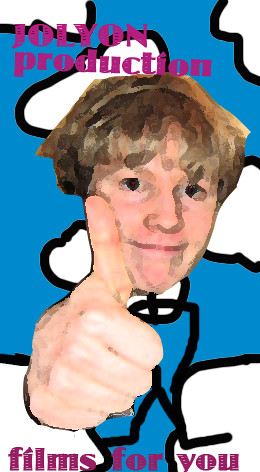

Evaluation of Production Logo
http://www.flickr.com/photos/56223899@N06/5375679074/
soundtrack analysis
This soundtrack would fit very nicely with a typical thriller film, because it would create a dark and unsettling mood for the film. This is because the use of the violin and the drum beats fitted together effectively, and this was due to the fact that the beats for the violin and the drums fitted together very well, and it was fast paced and created suspense and anticipation, which is what an audience would expect from a thriller theme tune. The theme tune also ends with a drum beat with no violin playing, which is good because if it were to be played during thriller opening credits, it would lead straight into the first scene and the general mood of the film would then be portrayed in this way for the rest of the film.
Thursday, 20 January 2011
Comparing opening theme tunes
Catch me if you can- in catch me if you can the music is climatic and fast paced, this is because it adds drama and a sense of action to the scene. clicking sounds which relates to the click of a clock, this is because time is an issue in this film may be there hero is fighting against time. the music is orchestral and jazzy, and this adds to the drama and suspense of the scene and relates to the visuals. Such examples of this are when the figure runs into the bar and escapes from the lift, but the music is used all the way through the scene, it is just altered at different parts of the scene to relate to these visuals.
The film is a crime thriller, and the opening theme music relates to this sub-genre effectively because the clicks relate to the idea of a gun being loaded before it's fired, which is obviously something you would expect to see in a crime thriller. The climatic and dark mood of the music also relates to the sub-genre well and engages the audiences interest.
Face-off - There is a lot of non-diegetic sound used in this opening scene, and once again, the music is climatic and fast paced, but this time the music has a different mood. The music starts off portraying a cheerful mood that relates to the visuals where a young boy is seen riding on a merry-go-round, relating to the cheerful mood of the music, in which bells could be heard. The diegetic sound that adds to this is the child's laughter, but quickly changes as the face-off title appears and the mood of the music changes from cheerful to dark, and once again this relates well to the visuals as a man is shot towards the end of the scene and one of the characters cries. The quick change in the mood portrayed by the music relates well to the crime sub-genre because it makes the opening scene more climatic and engages the audiences interest.
Panic Room - There are some ticking noises in the opening scene that add to the fast paced and climatic music to create an unsettling and dark mood for the opening scene; which relates well to the crime sub-genre. The ticking noises and music worked with the visuals where the city is shown in the background from different angles with the opening credits along the sides of them and since the font of the words is very big, it creates a dramatic and suspense-filled mood for the film.
The film is a crime thriller, and the opening theme music relates to this sub-genre effectively because the clicks relate to the idea of a gun being loaded before it's fired, which is obviously something you would expect to see in a crime thriller. The climatic and dark mood of the music also relates to the sub-genre well and engages the audiences interest.
Face-off - There is a lot of non-diegetic sound used in this opening scene, and once again, the music is climatic and fast paced, but this time the music has a different mood. The music starts off portraying a cheerful mood that relates to the visuals where a young boy is seen riding on a merry-go-round, relating to the cheerful mood of the music, in which bells could be heard. The diegetic sound that adds to this is the child's laughter, but quickly changes as the face-off title appears and the mood of the music changes from cheerful to dark, and once again this relates well to the visuals as a man is shot towards the end of the scene and one of the characters cries. The quick change in the mood portrayed by the music relates well to the crime sub-genre because it makes the opening scene more climatic and engages the audiences interest.
Panic Room - There are some ticking noises in the opening scene that add to the fast paced and climatic music to create an unsettling and dark mood for the opening scene; which relates well to the crime sub-genre. The ticking noises and music worked with the visuals where the city is shown in the background from different angles with the opening credits along the sides of them and since the font of the words is very big, it creates a dramatic and suspense-filled mood for the film.
Wednesday, 19 January 2011
BBFC Classification - 18 and 15
In this analysis, we are going to look at different classification and the reasoning behind their decision on films. We will look at classifications; '15' and '18'.
15 -
Drugs
Drugs in a '15' film maybe used but they must not be promoted or encourage misuse in anyway. The misuse of highly volatile substances will most probably not be permitted by the classification commitee.
Discrimination
The work as a whole must not endorse discrimination, such as 'racism'.
Theme
No theme is prohibited unless it's sadistic or has strong sexual connatation.
18 -
- No-one younger than 18 may see an ‘18’ film in a cinema.
- No-one younger than 18 may rent or buy an ‘18’ rated video.
This is all very well, putting down these regulations upon '18; films and dvd's alike, the problem lies when a parent purchases an 18 film for their son's or daughter's. Even though it clearly states, 'No-one younger than 18 may see an ‘18’ film.
In an '18' film there may be graphic horror with specific detail to 'blood & guts', aswell as frequently strong language.
'My Bloody Valentines', is considered an '18' bt the BBFC because it contains strong, frequent language and, detailed explicit horror. This film does not involve sex/sexual conduct.
15 -
Drugs
Drugs in a '15' film maybe used but they must not be promoted or encourage misuse in anyway. The misuse of highly volatile substances will most probably not be permitted by the classification commitee.
Discrimination
The work as a whole must not endorse discrimination, such as 'racism'.
Theme
No theme is prohibited unless it's sadistic or has strong sexual connatation.
18 -
- No-one younger than 18 may see an ‘18’ film in a cinema.
- No-one younger than 18 may rent or buy an ‘18’ rated video.
This is all very well, putting down these regulations upon '18; films and dvd's alike, the problem lies when a parent purchases an 18 film for their son's or daughter's. Even though it clearly states, 'No-one younger than 18 may see an ‘18’ film.
In an '18' film there may be graphic horror with specific detail to 'blood & guts', aswell as frequently strong language.
'My Bloody Valentines', is considered an '18' bt the BBFC because it contains strong, frequent language and, detailed explicit horror. This film does not involve sex/sexual conduct.
Tuesday, 18 January 2011
Analysing Past Students Work Q1-10
I would give their thriller a Level 3. Listed below are a series of comments and criticisms of the film and why I feel it deserves a Level 3:
1. There were a variety of shot distances used eg; close-ups and mid-shots. However, I would have liked to have seen more shots taken from further distances so that there is a greater variety of shot distances used
2. There were a large number of jump cuts used, which I felt were appropriate for a thriller, but I think it should've had a transition where the shot fades in/out to work with the thrilling elements of the film.
3. There was some dark, unsettling music used in the film which relates well to the thriller codes and conventions, but it didn't sound climatic enough, so as it came close to the end of the film, I wasn't expecting anything surprising (or thrilling) to happen.
4. Natural lighting was used, and this is typical of most thrillers in terms of micro-elements, which makes this thriller exceptional.
I would give their research and planning a level 3. Here are some reasons why:
1. Their analysis of thriller codes and conventions was of a high standard, but they should have analysed more thriller films so that their research would have gone into greater detail.
2. Their organisation when it came to bringing in props for their filming was sub-standard, because they didn't remember to bring them in. They should have had a discussion and shared the responsibilities and been responsible for their own props and what they brought in. If they had been, I would have given them more marks.
3. The level of presentation for their posts is really good, as they are colourful and work with different fonts, which makes them easier to analyse.
1. There were a variety of shot distances used eg; close-ups and mid-shots. However, I would have liked to have seen more shots taken from further distances so that there is a greater variety of shot distances used
2. There were a large number of jump cuts used, which I felt were appropriate for a thriller, but I think it should've had a transition where the shot fades in/out to work with the thrilling elements of the film.
3. There was some dark, unsettling music used in the film which relates well to the thriller codes and conventions, but it didn't sound climatic enough, so as it came close to the end of the film, I wasn't expecting anything surprising (or thrilling) to happen.
4. Natural lighting was used, and this is typical of most thrillers in terms of micro-elements, which makes this thriller exceptional.
I would give their research and planning a level 3. Here are some reasons why:
1. Their analysis of thriller codes and conventions was of a high standard, but they should have analysed more thriller films so that their research would have gone into greater detail.
2. Their organisation when it came to bringing in props for their filming was sub-standard, because they didn't remember to bring them in. They should have had a discussion and shared the responsibilities and been responsible for their own props and what they brought in. If they had been, I would have given them more marks.
3. The level of presentation for their posts is really good, as they are colourful and work with different fonts, which makes them easier to analyse.
Monday, 17 January 2011
Crime + Action Thriller codes and conventions
Crime Thrillers
Action Thrillers
In action thrillers, there are usually a lot of short duration shots used to match to the quick movements and reactions to the happenings and situations that take place in the film, and the fast paced, climatic music is used for films of this sub-genre as well. Mid-shots will often be used to give a better view of the characters' responses and actions, and the jump cuts that are used make the characters' responses and actions more fast and fluid whilst still maintaining continuity. Natural lighting is used to add to the dark and unsettling mood portrayed in the films. Such examples of films like these include "The Bourne Identity (1988) and "The Transporter (2002)".
In crime thrillers, there is usually fast paced, climatic music played to set the mood for the film.
The characters are usually dressed in dark clothes, and there is a killer/murderer. The thrillers themselves focus on the criminal(s), and the action is emphasised over the actual psychological aspects. Films such as these use a lot of tracking shots and natural lighting to focus on the moods and perspectives of the characters in the film. Such examples of films like these include "The Silence of The Lambs (1991)"
and "Hostage (2005)".
Action Thrillers
In action thrillers, there are usually a lot of short duration shots used to match to the quick movements and reactions to the happenings and situations that take place in the film, and the fast paced, climatic music is used for films of this sub-genre as well. Mid-shots will often be used to give a better view of the characters' responses and actions, and the jump cuts that are used make the characters' responses and actions more fast and fluid whilst still maintaining continuity. Natural lighting is used to add to the dark and unsettling mood portrayed in the films. Such examples of films like these include "The Bourne Identity (1988) and "The Transporter (2002)".
Thursday, 13 January 2011
Friday, 7 January 2011
Preliminary Evaluation
What did we learn?
We learnt about the importance of continuity through the use of the 180 degree rule. We also now know that the lighting being dark makes the scene more thrilling. It was also important for us to understand that since one of the characters is a ghost and we were producing a thriller, the girl who dies in it had to be killed by surprise, because if the viewing audience knows exactly when a character to be killed, it takes the surprise (or thrill) out of the thriller.
Were there any difficulties?
Our first problem we encountered was finding the location. At first we planned on filming our preliminary task in the refectory but as their was too many people in their and as their was too much light we could not film it their. We found a classroom which had blinds to overcome the problems.
Another problem we came across was when we were filming the door closing by its self at the end we had to re-film it lots of times because we had to ensure that the hand closing the door was not seen. Furthermore the door did not close fully every time so also had to re-film it then.
The girl in our thriller was also smiling as I was pretending to kill her with her scarf, so we had to cut the shots where she was smiling a lot to solve this problem.
How we constructed our preliminary task in relation to the micro areas
We learnt about the importance of continuity through the use of the 180 degree rule. We also now know that the lighting being dark makes the scene more thrilling. It was also important for us to understand that since one of the characters is a ghost and we were producing a thriller, the girl who dies in it had to be killed by surprise, because if the viewing audience knows exactly when a character to be killed, it takes the surprise (or thrill) out of the thriller.
Were there any difficulties?
Our first problem we encountered was finding the location. At first we planned on filming our preliminary task in the refectory but as their was too many people in their and as their was too much light we could not film it their. We found a classroom which had blinds to overcome the problems.
Another problem we came across was when we were filming the door closing by its self at the end we had to re-film it lots of times because we had to ensure that the hand closing the door was not seen. Furthermore the door did not close fully every time so also had to re-film it then.
The girl in our thriller was also smiling as I was pretending to kill her with her scarf, so we had to cut the shots where she was smiling a lot to solve this problem.
How we constructed our preliminary task in relation to the micro areas
- Dark lighting
- Shadows
- Mise-en-scene; props (scarf, book, desk)
- the location (dark and empty room)
- Camera work - Close up to show door handle, long shot to introduce character and location,
Subscribe to:
Posts (Atom)




